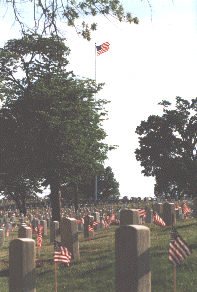Annapolis National Cemetery


Annapolis National Cemetery



Annapolis National Cemetery is one of fourteen original cemeteries created under the authority of legeslation - stating "That the President of the United States shall have power, whenever in his opinion it shall be expedient, to purchase cemetery grounds and cause them to be securely enclosed, to be used as a national cemetery for the soldiers who shall die in the service of the country." - passed by the 37th Congress and signed by President Abraham Lincoln on July 17, 1862.
The original cemeteries created under the Act of 1862 were established at logical points of need; due to its two field
hospitals, nearby parole camp, and the fact that it was an embarkation point, Annapolis was one of seven cemeteries
established at points of high troop concentration.
Because of the hurried manner in which the national
cemetery program was brought about, the fourteen original cemeteries were, as a rule, established within properties owned
by cemetery associations or by acquiring pre-existing private cemeteries. That is how Annapolis National Cemetery came
about; originally named Ash Grove, it was leased, on August 4, 1862 and again on December 5, 1863, from Judge Nicholas
Brewer for a period of 99 years. On February 28, 1871, the land was sold to the United States for a sum of $856.50.
The mammoth stone wall which encloses the cemetery was erected in 1871 in accordance with the Act to Establish and to Protect National Cemeteries of February 22, 1867. A brick lodge building, the quarters for the cemetery superintendent, was also erected in 1871. The brick building now located at the cemetery is not the original structure, but is built upon the 1871 foundation of the original structure.
According to historians, the title of Annapolis National Military Cemetery was not conferred upon Ash Grove until approximately 1870 due to the fact that there were - in addition to the hundreds of Union dead - nine Confedrate dead interred there.
Most of the interments in the Cemetery are from the Civil War, including 211 unknown United States and Confederate States soldiers. While burials still take place at the Cemetery (approximately 4 a year), there is no remaining "free" space; the interments which do occur are into reserved plots.
Since the Cemetery is for all intents and purposes "full" and there is sporadic activity, its operation is overseen by the Baltimore (Loudon Park) National Cemetery; groundskeeping is under contract for both Annapolis and Loudon Park.
Memorial Day flag placement is performed by local troops of the Boy Scouts of America; the flags are provided by the Department of Veterans Affairs through the Baltimore National Cemetery.
 Annapolis National Cemetery
Annapolis National Cemetery
ALIGN=MIDDLE>